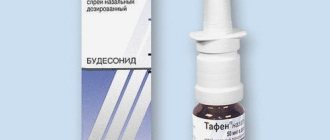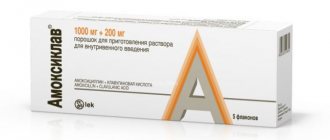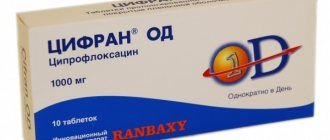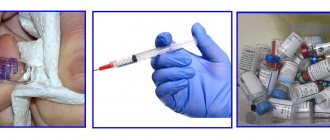Release form and composition
Tsiprolet is produced in the following dosage forms:
- Film-coated tablets: biconvex, round, smooth on both sides, almost white or off-white; on the fracture there is an almost white or white mass (10 pieces in blisters, 1 or 2 blisters in a cardboard box);
- Solution for infusion: light yellow, transparent, colorless (100 ml in low-density polyethylene bottles, 1 bottle in a cardboard box);
- Eye drops: transparent, light yellow or colorless (5 ml in dropper bottles, 1 bottle in a cardboard box).
1 tablet contains:
- Active substance: ciprofloxacin – 250 or 500 mg (in the form of ciprofloxacin hydrochloride monohydrate – 291.106 or 582.211 mg, respectively);
- Auxiliary components (250/500 mg, respectively): corn starch – 50.323/27.789 mg; microcrystalline cellulose – 7.486/5 mg; talc – 5/6 mg; croscarmellose sodium – 10/20 mg; colloidal silicon dioxide – 5/5 mg; Magnesium stearate – 3.514/4.5 mg;
- Film shell (250/500 mg, respectively): polysorbate 80 – 0.08/0.072 mg; hypromellose (6 cps) – 4.8/5 mg; titanium dioxide – 2/1.784 mg; sorbic acid – 0.08/0.072 mg; macrogol 6000 – 1.36/1.216 mg; talc – 1.6/1.784 mg; dimethicone – 0.08/0.072 mg.
The composition of 100 ml of solution for infusion includes:
- Active substance: ciprofloxacin – 200 mg;
- Auxiliary components: sodium chloride – 900 mg; edetate disodium – 10 mg; lactic acid – 75 mg; citric acid monohydrate – 12 mg; sodium hydroxide – 8 mg; hydrochloric acid – 0.0231 ml; water for injection – up to 100 ml.
The composition of 1 ml eye drops includes:
- Active substance: ciprofloxacin – 3 mg (in the form of ciprofloxacin hydrochloride – 3.49 mg);
- Auxiliary components: disodium edetate – 0.5 mg; hydrochloric acid – 0.000034 mg; sodium chloride – 9 mg; benzalkonium chloride 50% solution – 0.0002 ml; water for injection – up to 1 ml.
Tsiprolet price, where to buy
The price of Tsiprolet in tablets of 500 mg is 110 rubles per pack of 10 pieces.
The price of 250 mg tablets is approximately 55 rubles per pack.
The price of Tsiprolet in eye drops is 60 rubles.
You can always check the current cost of an antibiotic in online pharmacies, for which you can use our selection below. How much the drug costs depends on the country.
- Online pharmacies in RussiaRussia
- Online pharmacies in UkraineUkraine
- Online pharmacies in KazakhstanKazakhstan
ZdravCity
- Ciprolet tablets p.p.o.
500mg 10 pcs.Dr. Reddy's lab. 101 rub. order - Tsiprolet eye drops 3mg/ml 5mlDr. Reddy's lab.
53 RUR order
- Tsiprolet A tablets p.p.o. 500 mg+600 mg 10 pcs.Dr. Reddy's lab.
200 rub. order
- Ciprolet tablets p.p.o. 250mg 10 pcs.Dr. Reddy's lab.
56 RUR order
Pharmacy Dialogue
- Tsiprolet ch. drops (5ml bottle)Dr. Reddy's
57 RUR order
- Tsiprolet 500 tablets p/o 500 mg No. 10Dr. Reddy's
119 RUR order
- Tsiprolet A tablets 500mg+600mg No. 10Dr. Reddy's
230 rub. order
- Tsiprolet 250 tablets p/o 250 mg No. 10Dr. Reddy's
59 RUR order
show more
Pharmacy24
- Ciprolet 500 mg No. 10 tablets Dr. Reddy's Laboratories Ltd., India
82 UAH.order - Ciprolet 25 mg N10 tablets Dr. Reddy's Laboratories Ltd., India
53 UAH order
- Ciprolet A N10 tablets Dr. Reddy's Laboratories Ltd., India
147 UAH order
PaniPharmacy
- Tsiprolet tablets Tsiprolet tablets, film-coated 250 mg No. 10 India, Dr. Reddy's
58 UAH order
- Tsiprolet A tablets Tsiprolet A tablet. No. 10 India, Dr. Reddy's
161 UAH order
- Tsiprolet tablets Tsiprolet film-coated tablets 500 mg No. 10 India, Dr. Reddy's
107 UAH order
show more
Indications for use
Ciprolet in the form of tablets and solution for infusion is prescribed for the treatment of infectious and inflammatory diseases caused by microorganisms sensitive to the action of ciprofloxacin, including:
- Infections of the genital organs, respiratory tract, urinary tract and kidneys, ENT organs, biliary tract and gallbladder, skin, soft tissues and mucous membranes, musculoskeletal system, gastrointestinal tract (including teeth, mouth, jaws);
- Peritonitis;
- Sepsis.
The drug is also used in the treatment and prevention of infections in patients with reduced immunity (during the use of immunosuppressants).
Tsiprolet eye drops are prescribed for infectious and inflammatory diseases of the eye and its appendages caused by bacteria sensitive to the action of the drug, including:
- Blepharitis, blepharoconjunctivitis;
- Conjunctivitis (subacute and acute);
- Bacterial corneal ulcers;
- Chronic dacryocystitis and meibomitis;
- Keratoconjunctivitis and bacterial keratitis.
Drops are also indicated for preoperative prevention and treatment of postoperative infectious complications in ophthalmic surgery and for infectious complications of the eyes after exposure to foreign bodies or injuries (treatment and prevention).
Reviews about Tsiprolet
Reviews of Tsiprolet tablets
In general, the drug, of course, helps, since it is an antibiotic. However, it is worth remembering that it is for this reason that it should be taken only in extreme cases, so as not to harm health, especially in doses exceeding 500 mg. In particular, the annotation says that you should not take Tsiprolet before reaching adulthood, as this can negatively affect the skeleton. There are also reviews on the Internet about the side effects of this drug, such as weakness, dizziness, and difficulty breathing.
The drug is successfully taken for cystitis, but it is not recommended to stay in the sun for a long time while taking this antibiotic.
Reviews of Tsiprolet eye drops
Effective for conjunctivitis, blepharitis, stye. The drops are inexpensive.
Contraindications
- Viral keratitis (for eye drops);
- Pseudomembranous colitis (for tablets and solution for infusion);
- Glucose-6-phosphate dehydrogenase deficiency (for solution for infusion);
- Age up to 1 year (for eye drops) or up to 18 years (for tablets and solution for infusion).
Contraindications for all forms of release:
- Pregnancy and lactation;
- Hypersensitivity to the components of the drug or other drugs from the fluoroquinolone group.
Tsiprolet in all dosage forms should be prescribed with caution to patients with severe cerebral atherosclerosis, cerebrovascular accidents and convulsive syndrome.
The drug should be used orally and intravenously with caution in elderly patients, as well as in patients with epilepsy, mental illness, severe liver and/or kidney failure.
Directions for use and dosage
The dose of Tsiprolet is determined by the form of release of the drug, the severity of the disease, the type of infection, the condition of the body, body weight, age and functional state of the kidneys.
Tsiprolet in tablet form is taken orally, on an empty stomach, with a sufficient amount of liquid.
As a rule, the following dosage regimen is prescribed:
- Uncomplicated diseases of the urinary tract and kidneys, diseases of the lower respiratory tract of moderate severity: 2 times a day, 250 mg; in case of severe disease, the single dose may be doubled;
- Gonorrhea: 250-500 mg once;
- Gynecological diseases, enteritis and colitis with severe course and high temperature, prostatitis, osteomyelitis: 2 times a day, 500 mg (for the treatment of ordinary diarrhea, the single dose can be reduced by 2 times).
The duration of therapy is determined by the severity of the disease, however, Tsiprolet should be taken for at least another 2 days after the signs of the disease disappear. On average, the course duration is 7-10 days.
In case of severe renal dysfunction, 1/2 dose of the drug is prescribed.
In chronic renal failure, the dosage regimen is determined by creatinine clearance:
- More than 50 ml per minute: normal dosing regimen;
- 30-50 ml per minute: 1 time every 12 hours, 250-500 mg;
- 5-29 ml per minute: 250-500 mg once every 18 hours.
Patients on hemo- or peritoneal dialysis are administered 250-500 mg (after dialysis) once every 24 hours.
Tsiprolet in the form of a solution for infusion is administered intravenously over 30 minutes (200 mg each) and 60 minutes (400 mg each).
The infusion solution is compatible with Ringer's solution, 0.9% sodium chloride solution, 10% fructose solution, 5% and 10% dextrose solution, as well as a solution containing 5% dextrose solution with 0.45% or 0.225% sodium chloride solution.
The average single dose is 200 mg (for severe infections - 400 mg), the frequency of administration is 2 times a day. The duration of treatment is determined by the severity of the disease and averages 7-14 days. If necessary, the drug can be used for a longer period.
For the treatment of acute gonorrhea, a single intravenous injection of 100 mg of solution is indicated.
To prevent postoperative infections, Tsiprolet is administered intravenously at a dose of 200-400 mg 30-60 minutes before surgery.
Tsiprolet in the form of eye drops is used topically.
For moderate and mild infections, 1-2 drops are instilled into the conjunctival sac of the affected eye every 4 hours; in severe cases - 2 drops every hour. After improvement of the condition, the frequency of instillations and the dose are reduced.
When treating a bacterial corneal ulcer the following is prescribed:
- Day 1: 1 drop every 15 minutes for 6 hours, then 1 drop every 30 minutes during waking hours;
- 2nd day – every hour during waking hours, 1 drop;
- Days 3-14 – 1 drop every 4 hours during waking hours.
If after 14 days of treatment epithelialization has not occurred, therapy can be continued.
Tsiprolet injection solution 2mg/ml 100ml No. 1
CIPROLET® Ciprofloxacin Solution for infusion 200 mg/100 ml Registration number: P-8-242 No. 008395 Chemical name: 1-cyclopropyl-6-fluoro-1,4-dihydro-4-oxo-7-(1-piperazinyl)- 3-quinoline carboxylic acid Composition: Ciprolet solution for infusion - 100 ml of solution contains 200 mg of ciprofloxacin. Description: transparent, colorless liquid, free of visible foreign particles. Properties: Ciprofloxacin is an antimicrobial drug of the fluoroquinolone group. The mechanism of action of ciprofloxacin is associated with the effect on DNA gyrase (topoisomerase) of bacteria, which plays an important role in the reproduction of bacterial DNA. The drug has a rapid bactericidal effect on microorganisms that are both in the stage of rest and reproduction. The spectrum of action of ciprofloxacin includes the following types of gram(-) and gram(+) microorganisms: E.coli, Shigella, Salmonella, Citrobacter, Klebsiella, Enterobacter, Serratia, Hafnia, Edwardsiella, Proteus (indole-positive and indole-negative), Providencia, Moprganella, Yersinia, Vibrio, Aeromonas, Plesiomonas, Pasteurella, Haemophilus, Campylobacter, Pseudomonas, Legionella, Neisseria, Moraxella, Branhamella, Acinetobacter, Brucella, Staphylococcus, Streptococcus agalactiae, Listeria, Corynebacterium, Chlamydia. Ciprofloxacin is effective against bacteria that produce beta-lactamases. Sensitivity to ciprofloxacin varies in: Gardnerella, Flavobacterium, Alcaligenes, Streptococcus faecalis, Streptococcus pyogenes, Streptococcus pneumonia, Streptococcus viridans, Mycoplasma hominis, Mycobacterium tuberculosis, Mycobacterium fortuitum Most often resistant: Streptococcus faecium, Ureaplasma urealy ticum, Nocardia asteroides. Anaerobes, with some exceptions, are moderately sensitive (Peptococcus, Peptostreptococcus) or resistant (Bacteroides). Ciprofloxacin has no effect on Treponema pallidum and fungi. Resistance to ciprofloxacin develops slowly and gradually; plasmid resistance is absent. Ciprofloxacin is active against pathogens resistant, for example, to betalactam antibiotics, aminoglycosides or tetracyclines. Pharmacokinetics: After intravenous administration of ciprofloxacin, a high concentration in the blood plasma (up to 4 mcg/ml) is achieved within 20-30 minutes. Binding to plasma proteins is negligible (20-40%). Volume of distribution - 2-3 l/kg. Ciprofloxacin penetrates well into organs and tissues. Approximately 2 hours after ingestion or intravenous administration, it is found in tissues and body fluids in concentrations many times higher than in blood serum. Ciprofloxacin is excreted from the body mainly unchanged, mainly through the kidneys. The plasma half-life after both oral and intravenous administration is 3 to 5 hours. Significant amounts of the drug are also excreted in bile and feces, so only significant impairment of renal function leads to a slower elimination. Indications: Treatment of uncomplicated and complicated infections caused by pathogens sensitive to the drug: respiratory tract infections. For outpatient treatment of pneumococcal pneumonia, ciprofloxacin is not a first-line drug, but it is indicated for pneumonia caused, for example, by Klebsiella, Enterobacter, bacteria of the genus Pseudomonas, Haemophilus influenzae, bacteria of the genus Branhamella, Legionella, Staphylococcus; infections of the middle ear and paranasal sinuses, especially if they are caused by gram-negative bacteria, including bacteria of the genus Pseudomonas, or staphylococci; eye infections; kidney and urinary tract infections; skin and soft tissue infections; bone and joint infections; infections of the pelvic organs (including adnexitis and prostatitis); gonorrhea; gastrointestinal infections; infections of the gallbladder and biliary tract;; peritonitis; sepsis. Prevention and treatment of infections in patients with reduced immunity (for example, during treatment with immunosuppressants and neutropenia); Selective intestinal decontamination during treatment with immunosuppressants. Contraindications: hypersensitivity to ciprofloxacin and other quinolone drugs, pregnancy, lactation, childhood and adolescence. Cautions: Ciprofloxacin should be used with caution in elderly patients. For patients with epilepsy, a history of seizures, vascular diseases and organic brain damage due to the risk of developing adverse reactions from the central nervous system, ciprofloxacin should be prescribed only for health reasons. During treatment with ciprofloxacin, adequate hydration is necessary to prevent possible crystalluria. Side effects: Ciprofloxacin is well tolerated by patients. When treated with ciprofloxacin, the following, usually reversible, side effects may occur: From the cardiovascular system: in very rare cases - tachycardia, hot flashes, migraine, fainting. From the gastrointestinal tract and liver: nausea, vomiting, diarrhea, digestive disorders, abdominal pain, flatulence, lack of appetite. From the nervous system and psyche: dizziness, headache, fatigue, insomnia, agitation, tremor; in very rare cases: peripheral sensory disturbances, sweating, unsteady gait, seizures, feelings of fear and confusion, nightmares, depression, hallucinations, disturbances of taste and smell, visual disturbances (diplopia, chromatopsia), tinnitus, temporary hearing loss especially in high sounds. If these reactions occur, you should immediately discontinue the drug and notify your doctor. From the hematopoietic system: eosinophilia, leukopenia, thrombocytopenia, very rarely - leukocytosis, thrombocytosis, hemolytic anemia. Allergic and immunopathological reactions: skin rashes, itching, drug fever, as well as photosensitivity; rarely - Quincke's edema, bronchospasm, arthralgia; very rarely - anaphylactic shock, myalgia, Stevens-Johnson syndrome, Lyell's syndrome, interstitial nephritis, hepatitis. Local reactions: phlebitis Musculoskeletal system: there are isolated reports that the use of ciprofloxacin was accompanied by ruptures of the tendons of the shoulder, arms and Achilles tendon, requiring surgical intervention. If complaints occur, treatment should be stopped. Effect on laboratory parameters: especially in patients with impaired liver function, there may be a temporary increase in the level of transaminases and alkaline phosphatase, as well as cholestatic jaundice: a temporary increase in the concentration of urea, creatinine and bilirubin in the blood serum, hyperglycemia. Advice for road users: Even when used properly, this medicinal product can alter the ability to concentrate to such an extent that the ability to drive a vehicle or operate machinery is impaired. This especially applies to cases of interaction with alcohol. Overdose: No specific antidote is known. Routine emergency measures are recommended, as well as hemodialysis and peritoneal dialysis. Interaction with other drugs: When using ciprofloxacin and theophylline simultaneously, the concentration of theophylline in the blood plasma should be monitored and its dose adjusted, because An undesirable increase in the concentration of theophylline in the blood serum and the development of corresponding side effects may be observed. With the simultaneous use of ciprofloxacin and cyclosporine, in some cases an increase in serum creatinine concentration was observed, therefore, such patients require frequent (2 times a week) monitoring of this indicator. With simultaneous use of ciprofloxacin and warfarin, the effect of warfarin may be enhanced. Animal studies have shown that very high doses of quinolones and some non-steroidal anti-inflammatory drugs (but not acetylsalicylic acid) can cause seizures. However, such drug interactions were not observed in patients. Ciprofloxacin can be used in combination with azlocillin and ceftazidime for infections caused by Pseudomonas, with mezlocillin, azlocillin and other effective beta-lactam antibiotics for streptococcal infections; with isoxazoylpenicillins, vancomycin - for staphylococcal infections, with metronidazole, clindamycin - for anaerobic infections. Method of administration and dosage: In the absence of special prescriptions from a doctor, the following approximate doses are recommended: Indications for use Single/daily doses for adults ________________________________________________________________________________ Uncomplicated lower and upper urinary tract infections 2 x 100 mg Complicated urinary tract infections (depending on severity) 2 x 200 mg Respiratory tract infections 2 x 200-400 mg Other infections 2 x 200-400 mg ________________________________________________________________________________ Acute gonorrhea and acute uncomplicated cystitis in women can be treated with a single dose of 200 mg (intravenously). For urinary tract infections, including acute uncomplicated gonorrhea, ciprofloxacin can be administered intravenously at a dose of 100 mg 2 times a day. For respiratory tract infections, depending on the severity and pathogen, ciprofloxacin is administered at a dose of 200-400 mg 2 times a day, for other infections - 200-400 mg 2 times a day. As the patient's condition improves, they switch to taking the drug orally. Patients with impaired renal function: When creatinine clearance is less than 20 ml/min (or serum creatinine level is above 3 mg/100 ml), the following is prescribed: 2 times a day, half the standard dose or 1 time per day, the full standard dose. Patients with impaired liver function: No dose adjustment is required. Patients on peritoneal dialysis: For peritonitis, ciprofloxacin is prescribed orally at a dose of 0.5 g 4 times a day or the drug is added in the form of a solution for infusion at a dose of 0.05 g 4 times a day per 1 liter of dialysate intraperitoneally. Duration of use: The duration of treatment depends on the severity of the disease, clinical course and results of bacteriological examination. The presence of Tsiprolet in two dosage forms allows you to begin treatment of severe infections intravenously and continue it orally. It is recommended to continue treatment for at least 3 days after the temperature normalizes or clinical symptoms disappear. The duration of treatment for acute uncomplicated gonorrhea and cystitis is 1 day. For infections of the kidneys, urinary tract and abdominal cavity - up to 7 days. For osteomyelitis, the course of treatment can be up to 2 months. For other infections, the course of treatment is 7-14 days. In patients with reduced immunity, treatment is carried out throughout the entire period of neutropenia. Directions for use: The duration of infusion should be 30 minutes at a dose of 200 mg and 60 minutes at a dose of 400 mg. The drug solution can be administered undiluted or after adding to other infusion solutions. Ciprofloxacin solution contains 0.9% sodium chloride and is compatible with the following infusion solutions: 0.9% sodium chloride solution, Ringer's solution, and Hartmann's lactated Ringer's solution, 5% and 10% glucose solutions, 10% fructose solution, and 5 % glucose solution containing 0.225% or 0.45% sodium chloride. Release form: Bottle containing 100 ml of solution for infusion (200 mg of ciprofloxacin). Storage conditions: In a dry, dark place at temperatures up to 25°C. Do not freeze. Expiration date is indicated on the label. Tsiprolet is not allowed to be used after the expiration date! Dispensed with a doctor's prescription: Keep out of the reach of children!
Side effects
When using Tsiprolet orally and intravenously, the following side effects may develop:
- Cardiovascular system: heart rhythm disturbances, tachycardia, low blood pressure, flushing of the face;
- Urinary system: interstitial nephritis, hematuria, crystalluria (primarily with low diuresis and alkaline urine), glomerulonephritis, polyuria, dysuria, albuminuria, urinary retention, urethral bleeding, decreased nitrogen excretory function of the kidneys;
- Musculoskeletal system: tendon ruptures, arthralgia, tendovaginitis, arthritis, myalgia;
- Hematopoietic system: thrombocytosis, granulocytopenia, leukopenia, thrombocytopenia, anemia, leukocytosis, hemolytic anemia;
- Digestive system: anorexia, abdominal pain, nausea, vomiting, diarrhea, flatulence, cholestatic jaundice (especially in patients with previous liver diseases), hepatonecrosis, hepatitis, increased activity of liver transaminases and alkaline phosphatase;
- Nervous system: headache, dizziness, tremor, increased fatigue, insomnia, nightmares, peripheral paralgesia (anomaly in the perception of pain), increased intracranial pressure, sweating, anxiety, depression, confusion, hallucinations, as well as other manifestations of psychotic reactions (rarely they can progress to conditions in which the patient is capable of harming himself), fainting, migraine, thrombosis of the cerebral arteries;
- Sense organs: hearing loss, tinnitus, disturbances of smell and taste, visual disturbances (diplopia, changes in color vision);
- Laboratory indicators: hypercreatininemia, hypoprothrombinemia, hyperglycemia, hyperbilirubinemia;
- Allergic reactions: the appearance of small nodules and blisters forming scabs, accompanied by bleeding, skin itching, drug fever, urticaria, pinpoint hemorrhages (petechiae), vasculitis, swelling of the larynx or face, eosinophilia, shortness of breath, increased photosensitivity, erythema nodosum, exudative erythema multiforme, toxic epidermal necrolysis (Lyell's syndrome), Stevens-Johnson syndrome (malignant exudative erythema);
- Other: general weakness, superinfections (candidiasis, pseudomembranous colitis).
When administered intravenously, local reactions may occur, manifested by pain and burning at the injection site, and the development of phlebitis.
When using Tsiprolet in the form of eye drops, the following disorders may develop:
- Organ of vision: burning, itching, hyperemia and mild soreness of the conjunctiva; rarely - photophobia, swelling of the eyelids, lacrimation, feeling of a foreign body in the eyes, decreased visual acuity, the appearance of a white crystalline precipitate in patients with a corneal ulcer, keratopathy, keratitis, corneal infiltration;
- Other: nausea, allergic reactions; rarely – development of superinfection, unpleasant taste in the mouth immediately after instillation.
special instructions
Patients with epilepsy, a history of seizures, vascular diseases and organic brain damage due to the threat of adverse reactions from the central nervous system should be prescribed Tsiprolet orally only for health reasons.
If prolonged and severe diarrhea occurs during or after use of the drug orally or intravenously, it is necessary to exclude the presence of pseudomembranous colitis, which requires immediate discontinuation of Tsiprolet and the appointment of appropriate therapy. Treatment should be stopped if tendon pain develops or when the first signs of tenosynovitis appear.
When using the drug in the form of tablets and solution for infusion, a sufficient amount of fluid should be provided while maintaining normal diuresis.
Tsiprolet eye drops can only be used topically; the drug cannot be administered into the anterior chamber of the eye or subconjunctivally. When using the drug and other ophthalmic solutions, the interval between their administrations should be at least 5 minutes. During therapy, wearing contact lenses is not recommended.
When using Tsiprolet, you must be careful when driving a car and performing other potentially dangerous types of work that require high attention and rapid psychomotor reactions (especially in combination with alcohol).
Analogues of Tsiprolet
Level 4 ATX code matches:
Dancil
Oftadek
Signitsef
Oftaquix
Vitabact
Okomistin
Analogues of Tsiprolet in composition are the following drugs: Alox , Floximed , Ciloxan , Ciproxol , Tsipromed , Tsipropharm , Ciprofloxacin , Tsifran , Tsiprol , Cipronate , Ificipro , Medociprin and others.
Are Tsiprolet and Tsifran the same thing?
Tsifran is an analogue of the drug in terms of the active substance.
Drug interactions
In the case of simultaneous use of Tsiprolet with certain medications, undesirable effects may occur:
- Didanosine: decreased absorption of ciprofloxacin;
- Theophylline: an increase in its concentration in the blood plasma and the risk of developing toxic effects;
- Antacids, as well as drugs containing zinc, aluminum, magnesium or iron ions: decreased absorption of ciprofloxacin (the break between use with these drugs should be at least 4 hours);
- Anticoagulants: prolongation of bleeding time;
- Cyclosporine: increased nephrotoxic effect;
- Nonsteroidal anti-inflammatory drugs (except acetylsalicylic acid): increased risk of seizures;
- Metoclopramide: acceleration of absorption of ciprofloxacin;
- Uricosuric drugs: slower elimination and increased plasma concentration of ciprofloxacin;
- Indirect anticoagulants: enhancing their action.
When Tsiprolet is used simultaneously with other antimicrobial drugs, synergistic action is possible. Depending on the infection, Tsiprolet can be used in combination with the following drugs:
- Azlocillin, ceftazidime: infections caused by Pseudomonas spp.;
- Mezlocillin, azlocillin and other beta-lactam antibiotics: streptococcal infections;
- Isoxazolylpenicillins and vancomycin: staphylococcal infections;
- Metronidazole, clindamycin: anaerobic infections.
Tsiprolet infusion solution is pharmaceutically incompatible with all drugs and infusion solutions that are physicochemically unstable in an acidic environment (pH of ciprofloxacin infusion solution is 3.5-4.6). The solution for intravenous administration should not be mixed with solutions with a pH greater than 7.








